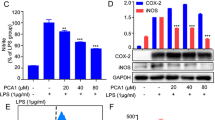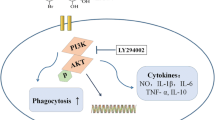Abstract
Objective
To explore the anti-inflammatory effect of the traditional Chinese medicine Zhikang capsule (ZKC) on lipopolysaccharide (LPS)-induced RAW264.7 cells.
Methods
Safe concentrations of ZKC (0.175, 0.35, and 0.7 mg/mL) were used after the half-maximal inhibitory concentration (IC50) of RAW264.7 cells was calculated through the CCK-8 assay. In addition, the optimal intervention duration of ZKC (0.7 mg/mL) on RAW264.7 cells was determined to be 6 h, since all proinflammatory mediators [tumor necrosis factor-alpha (TNF-α), interleukin-1 beta (IL-1β), inteleukin-6 (IL-6), cyclooxygenase-2 (COX-2), inducible nitric oxide synthase (iNOS), and monocyte chemotactic protein-1 (MCP-1)] had a decreasing tendency and relatively down-regulated mRNA expression levels as compared with other durations (4, 8, and 12 h). RAW264.7 cells were pretreated with ZKC at various concentrations (0.175, 0.35 and 0.7 mg/mL) for 6 h and then stimulated with LPS (1 µg/mL) for an additional 12 h.
Results
In terms of inflammation, ZKC could reverse LPS-induced upregulation of TNF-α, IL-1β, IL-6, COX-2, iNOS, and MCP-1 at both the mRNA and protein levels in RAW264.7 cells in a dose-dependent manner. In terms of the NF-κB signaling pathway, ZKC could reduce phosphorylated p65 and promote M2 polarization of RAW264.7 cells under LPS stimulation in a dose-dependent manner. Moreover, ZKC exhibited a protective effect on macrophages from apoptosis.
Conclusion
ZKC exhibited obvious antiinflammatory and anti-apoptotic effects on LPS-induced RAW264.7 cells at the cellular level, and a weakened NF-κB signaling pathway may be a potential significant target.
Similar content being viewed by others
References
Boshtam M, Asgary S, Kouhpayeh S, et al. Aptamers against pro- and anti-inflammatory cytokines: a review. Inflammation, 2017,40(1):340–349
Chrobok NL, Sestito C, Wilhelmus MM, et al. Is monocyte- and macrophage-derived tissue transglutaminase involved in inflammatory processes? Amino Acids, 2017,49(3):441–452
Fougère B, Boulanger E, Nourhashémi F, et al. Chronic inflammation: accelerator of biological aging. J Gerontol A Biol Sci Med Sci, 2017,72(9):1218–1225
Viola J, Soehnlein O. Atherosclerosis-a matter of unresolved inflammation. Semin Immunol, 2015,27(3):184–193
Tall AR, Yvan-Charvet L. Cholesterol, inflammation and innate immunity. Nat Rev Immunol, 2015,15(2):104–116
Felice FG, Ferreira ST. Inflammation, defective insulin signaling, and mitochondrial dysfunction as common molecular denominators connecting type 2 diabetes to Alzheimer disease. Diabetes, 2014,63(7):2262–2272
Conway EM, Pikor LA, Kung SH, et al. Macrophages, inflammation, and lung cancer. Am J Respir Crit Care Med, 2016,193(2):116–130
Lissner D, Schumann M, Batra A, et al. Monocyte and M1 macrophage-induced barrier defect contributes to chronic intestinal inflammation in IBD. Inflamm Bowel Dis, 2015,21(6):1297–1305
Wynn TA, Chawla A, Pollard JW. Macrophage biology in development, homeostasis and disease. Nature, 2013,496(7446):445–455
Cho YC, Ju A, Kim BR, et al. Anti-inflammatory effects of Crataeva nurvala Buch. Ham. are mediated via inactivation of ERK but not NF-kappaB. J Ethnopharmacol, 2015,162:140–147
Steinbach EC, Plevy SE. The role of macrophages and dendritic macrophages in the initiation of inflammation in IBD. Inflamm Bowel Dis, 2014,20(1):166–175
Shapouri-Moghaddam A, Mohammadian S, Vazini H, et al. Macrophage plasticity, polarization, and function in health and disease. J Cell Physiol, 2018,233(9):6425–6440
Orecchioni M, Ghosheh Y, Pramod AB, et al. Macrophage polarization: different gene signatures in M1(LPS+) vs. classically and M2(LPS-) vs. alternatively activated macrophages. Front Immunol, 2019,10:1084
Cheng C, Zou Y, Peng J. Oregano essential oil attenuates RAW264.7 macrophages from lipopolysaccharide-induced inflammatory response through regulating NADPH oxidase activation-driven oxidative stress. Molecules, 2018,23(8):1857
Sigola LB, Fuentes AL, Millis LM, et al. Effects of toll-like receptor ligands on RAW 264.7 macrophage morphology and zymosan phagocytosis. Tissue Cell, 2016,48(4):389–396
Han C, Fu J, Liu Z, et al. Dipyrithione inhibits IFN-gamma-induced JAK/STAT1 signaling pathway activation and IP-10/CXCL10 expression in RAW264.7 macrophages. Inflamm Res, 2010,59(10):809–816
Meng XM, Mak TS, Lan HY. Macrophages in renal fibrosis. Adv Exp Med Biol, 2019,1165:285–303
Zong Z, Zou J, Mao R, et al. M1 macrophages induce PD-L1 expression in hepatocellular carcinoma macrophages through IL-1β signaling. Front Immunol, 2019,10:1643
Engin AB. Adipocyte-macrophage cross-talk in obesity. Adv Exp Med Biol, 2017,960:327–343
Dou F, Chen J, Cao H, et al. Anti-atherosclerotic effects of LXRα agonist through induced conversion of M1 macrophage to M2. Am J Transl Res, 2019,11(6):3825–3840
Wang Y, Jin J. Roles of macrophages in formation and progression of intracranial aneurysms. Zhejiang Da Xue Xue Bao Yi Xue Ban, 2019,48(2):204–213
Hoesel B, Schmid JA. The complexity of NF-kB signaling in inflammation and cancer. Mol Cancer, 2013,12:86
Wang H, Zhu Y, Xu X, et al. Ctenopharyngodon idella NF-kB subunit p65 modulates the transcription of IκBα in CIK macrophages. Fish Shellfish Immunol, 2016,54:564–572
Hou J, Jiang S, Zhao J, et al. N-Myc-interacting protein negatively regulates TNF-α-induced NF-κB transcriptional activity by sequestering NF-κB/p65 in the cytoplasm. Sci Rep, 2017,7(1):14579
Zhang Q, Lenardo MJ, Baltimore D. 30 years of NF-κB: a blossoming of relevance to human pathobiology. Cell, 2017,168(1–2):37–57
Hayden MS, Ghosh S. Shared principles in NF-kappaB signaling. Cell, 2008,132(3):344–362
Kauppinen A, Suuronen T, Ojala J, et al. Antagonistic crosstalk between NF-κB and SIRT1 in the regulation of inflammation and metabolic disorders. Cell Signal, 2013,25(10):1939–1948
Cao SY, Ye SJ, Wang WW, et al. Progress in active compounds effective on ulcerative colitis from Chinese medicines. Chin J Nat Med, 2019,17(2):81–102
Fei L, Xu K. Zhikang Capsule ameliorates dextran sodium sulfate-induced colitis by inhibition of inflammation, apoptosis, oxidative stress and MyD88-dependent TLR4 signaling pathway. J Ethnopharmacol, 2016,192:236–247
Deng X, Pan X, Cheng C, et al. Regulation of SREBP-2 intracellular trafficking improves impaired autophagic flux and alleviates endoplasmic reticulum stress in NAFLD. Biochim Biophys Acta Mol Cell Biol Lipids, 2017,1862(3):337–350
Cheng C, Deng X, Xu K. Increased expression of sterol regulatory element binding protein-2 alleviates autophagic dysfunction in NAFLD. Int J Mol Med, 2018,41(4):1877–1886
Hokari R, Kato S, Matsuzaki K, et al. Reduced sensitivity of inducible nitric oxide synthase-deficient mice to chronic colitis. Free Radic Biol Med, 2001,31(2):153–63
Che D, Zhang S, Jing Z, et al. Macrophages induce EMT to promote invasion of lung cancer macrophages through the IL-6-mediated COX-2/PGE2/β-catenin signalling pathway. Mol Immunol, 2017,90:197–210
Vogel DY, Glim JE, Stavenuiter AW, et al. Human macrophage polarization in vitro: maturation and activation methods compared. Immunobiology, 2014,219(9):695–703
Barros MH, Hauck F, Dreyer JH, et al. Macrophage polarisation: an immunohistochemical approach for identifying M1 and M2 macrophages. PLoS One, 2013,8(11):e80908
Jablonski KA, Amici SA, Webb LM, et al. Novel markers to delineate murine M1 and M2 macrophages. PLoS One, 2015,10(12):e0145342
Afrin S, Gasparrini M, Forbes-Hernández TY, et al. Protective effects of Manuka honey on LPS-treated RAW 264.7 macrophages. Part 1: Enhancement of cellular viability, regulation of cellular apoptosis and improvement of mitochondrial functionality. Food Chem Toxicol, 2018,121:203–213
Karpurapu M, Wang X, Deng J, et al. Functional PU.1 in macrophages has pivotal role in NF-κB activation and neutrophilic lung inflammation during endotoxemia. Blood, 2011,118(19):5255–5266
Lee HJ, Kim KW. Anti-inflammatory effects of arbutin in lipopolysaccharide-stimulated BV2 microglial macrophages. Inflamm Res, 2012,61(8):817–25
Geng J, Liu H, Ge P, et al. PM2.5 promotes plaque vulnerability at different stages of atherosclerosis and the formation of foam macrophages via TLR4/MyD88/NFκB pathway. Ecotoxicol Environ Saf, 2019,176:76–84
Chen Q, Zhang KX, Li TY, et al. Cardamine komarovii flower extract reduces lipopolysaccharide-induced acute lung injury by inhibiting MyD88/TRIF signaling pathways. Chin J Nat Med, 2019,17(6):461–468
Somensi N, Rabelo TK, Guimarães AG, et al. Carvacrol suppresses LPS-induced pro-inflammatory activation in RAW 264.7 macrophages through ERK1/2 and NF-κB pathway. Int Immunopharmacol, 2019,75:105–743
Hung YL, Fang SH, Wang SC, et al. Corylin protects LPS-induced sepsis and attenuates LPS-induced inflammatory response. Sci Rep, 2017,7:46–299
Chen Y, Xian Y, Lai Z, et al. Anti-inflammatory and antiallergic effects and underlying mechanisms of Huang-Lian-Jie-Du extract: Implication for atopic dermatitis treatment. J Ethnopharmacol, 2016,185:41–52
Liu J, Feng L, Ma D, et al. Neuroprotective effect of paeonol on cognition deficits of diabetic encephalopathy in streptozotocin-induced diabetic rat. Neurosci Lett, 2013,549:63–68
Wen Q, Mei L, Ye S, et al. Chrysophanol demonstrates anti-inflammatory properties in LPS-primed RAW 264.7 macrophages through activating PPAR-γ. Int Immunopharmacol, 2018,56:90–97
Ge H, Tang H, Liang Y, et al. Rhein attenuates inflammation through inhibition of NF-κB and NALP3 inflammasome in vivo and in vitro. Drug Des Devel Ther, 2017,11:1663–1671
Huang C, Cheng L, Feng X, et al. Dencichine ameliorates renal injury by improving oxidative stress, apoptosis and fibrosis in diabetic rats. Life Sci, 2020,258:118146
Hu B, Zhang H, Meng X, et al. Aloe-emodin from rhubarb (Rheum rhabarbarum) inhibits lipopolysaccharide-induced inflammatory responses in RAW264.7 macrophages. J Ethnopharmacol, 2014,153(3):846–853
Wu Y, Tu X, Lin G, et al. Emodin-mediated protection from acute myocardial infarction via inhibition of inflammation and apoptosis in local ischemic myocardium. Life Sci, 2007,81(17–18):1332–1338
Kao TC, Shyu MH, Yen GC. Glycyrrhizic acid and 18beta-glycyrrhetinic acid inhibit inflammation via PI3K/Akt/GSK3beta signaling and glucocorticoid receptor activation. J Agric Food Chem, 2010,58(15):8623–8629
Guo W, Sun J, Jiang L, et al. Imperatorin attenuates LPS-induced inflammation by suppressing NF-κB and MAPKs activation in RAW 264.7 macrophages. Inflammation, 2012,35(6):1764–1772
Kaplan GG. The global burden of IBD: from 2015 to 2025. Nat Rev Gastroenterol Hepatol, 2015,12(12):720–727
Zhang J, Zeng YF, Xiao BQ, et al. Treatment of ulcerative colitis by combined therapy of retention enema and per-colonoscopic spraying with zhikang capsule compound liquid. Zhongguo Zhong Xi Yi Jie He Za Zhi (Chinese), 2005,25(9):839–842
Cheng C, Lv Y, Zhang E, et al. Effects of the Zhikang capsule on healing of the flap after radical breast cancer surgery. Genet Mol Res, 2015,14(2):5127–5131
George L, Ramasamy T, Sirajudeen K, et al. LPS-induced apoptosis is partially mediated by hydrogen sulphide in RAW 264.7 murine macrophages. Immunol Invest, 2019,48(5):451–465
Seminara AR, Ruvolo PP, Murad F. LPS/IFNgamma-induced RAW 264.7 apoptosis is regulated by both nitric oxide-dependent and -independent pathways involving JNK and the Bcl-2 family. Cell Cycle, 2007,6(14):1772–1778
Author information
Authors and Affiliations
Corresponding author
Additional information
Conflict of Interest Statement
The authors declare that there is no conflict of interest to reveal.
Rights and permissions
About this article
Cite this article
Xin, Sl., Yang, X., Zhang, Yp. et al. Zhikang Capsule Ameliorates Inflammation, Drives Polarization to M2 Macrophages, and Inhibits Apoptosis in Lipopolysaccharide-induced RAW264.7 Cells. CURR MED SCI 41, 1214–1224 (2021). https://doi.org/10.1007/s11596-021-2441-z
Received:
Accepted:
Published:
Issue Date:
DOI: https://doi.org/10.1007/s11596-021-2441-z




